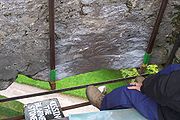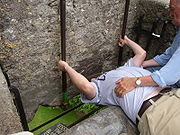
Blarney Stone
Encyclopedia

Bluestone
Bluestone is a cultural or commercial name for a number of dimension or building stone varieties, including:*a feldspathic sandstone in the U.S. and Canada;*limestone in the Shenandoah Valley in the U.S...
built into the battlement
Battlement
A battlement in defensive architecture, such as that of city walls or castles, comprises a parapet , in which portions have been cut out at intervals to allow the discharge of arrows or other missiles. These cut-out portions form crenels...
s of Blarney Castle
Blarney Castle
Blarney Castle is a medieval stronghold in Blarney, near Cork, Ireland, and the River Martin. Though earlier fortifications were built on the same spot, the current keep was built by the MacCarthy of Muskerry dynasty, a cadet branch of the Kings of Desmond, and dates from 1446...
, Blarney
Blarney
Blarney is a town and townland in County Cork, Ireland. It lies north-west of Cork and is famed as the site of Blarney Castle, home of the legendary Blarney Stone.-Tourism:Blarney town is a major tourist attraction in County Cork...
, about 8 kilometres (5 mi) from Cork
Cork (city)
Cork is the second largest city in the Republic of Ireland and the island of Ireland's third most populous city. It is the principal city and administrative centre of County Cork and the largest city in the province of Munster. Cork has a population of 119,418, while the addition of the suburban...
, Ireland
Republic of Ireland
Ireland , described as the Republic of Ireland , is a sovereign state in Europe occupying approximately five-sixths of the island of the same name. Its capital is Dublin. Ireland, which had a population of 4.58 million in 2011, is a constitutional republic governed as a parliamentary democracy,...
. According to legend, kissing the stone endows the kisser with the gift of the gab (great eloquence
Eloquence
Eloquence is fluent, forcible, elegant or persuasive speaking. It is primarily the power of expressing strong emotions in striking and appropriate language, thereby producing conviction or persuasion...
or skill at flattery
Flattery
Flattery is the act of giving excessive compliments, generally for the purpose of ingratiating oneself with the subject....
). The stone was set into a tower of the castle in 1446. The castle is a popular tourist site in Ireland, attracting visitors from all over the world to kiss the stone and tour the castle and its gardens.
The word blarney has come to mean "clever, flattering, or coaxing talk".
Origins
An early story involves the goddess ClíodhnaCliodhna
Clíodhna is a Queen of the Banshees of the Tuatha Dé Danann. In Irish literature, Cleena of Carrigcleena is the potent banshee that rules as queen over the sheoques of South Munster, or Desmond. She is the principal goddess of this country...
. Cormac Laidir MacCarthy, the builder of Blarney Castle, being involved in a lawsuit, appealed to Clíodhna for her assistance. She told MacCarthy to kiss the first stone he found in the morning on his way to court, and he did so, with the result that he pleaded his case with great eloquence and won. Thus the Blarney Stone is said to impart "the ability to deceive without offending." MacCarthy then incorporated it into the parapet
Parapet
A parapet is a wall-like barrier at the edge of a roof, terrace, balcony or other structure. Where extending above a roof, it may simply be the portion of an exterior wall that continues above the line of the roof surface, or may be a continuation of a vertical feature beneath the roof such as a...
of the castle.

Robert I of Scotland
Robert I , popularly known as Robert the Bruce , was King of Scots from March 25, 1306, until his death in 1329.His paternal ancestors were of Scoto-Norman heritage , and...
in 1314 in recognition of his support in the Battle of Bannockburn
Battle of Bannockburn
The Battle of Bannockburn was a significant Scottish victory in the Wars of Scottish Independence...
. This legend holds that this was a piece of the Stone of Scone
Stone of Scone
The Stone of Scone , also known as the Stone of Destiny and often referred to in England as The Coronation Stone, is an oblong block of red sandstone, used for centuries in the coronation of the monarchs of Scotland and later the monarchs of England, Great Britain and the United Kingdom...
and was installed at McCarthy's castle of Blarney. Although colourful, this folk legend does not account for that fact that it supposes that the stone was removed from Scotland 18 years before Bannockburn.
Ritual

Acrophobia
Acrophobia is an extreme or irrational fear of heights. It belongs to a category of specific phobias, called space and motion discomfort that share both similar etiology and options for treatment.Most people experience a degree of natural fear when exposed to heights, especially if there is little...
, an extreme or irrational fear of heights.
In 2009, Tripadvisor.com ranked the Blarney Stone as the most unhygienic tourist attraction in the world (although it admitted it had no scientific evidence to back its case).
Before the safeguards were installed, the kiss was performed with real risk to life and limb, as participants were grasped by the ankles and dangled bodily from the height. In the Sherlock Holmes
Sherlock Holmes
Sherlock Holmes is a fictional detective created by Scottish author and physician Sir Arthur Conan Doyle. The fantastic London-based "consulting detective", Holmes is famous for his astute logical reasoning, his ability to take almost any disguise, and his use of forensic science skills to solve...
radio dramatisation "The Adventure of the Blarney Stone" (first broadcast March 18, 1946), a man attempting to kiss the Blarney Stone falls to his death. Holmes' investigation reveals this as a murder, the man's boots having been surreptitiously greased before the attempt.
William Henry Hurlbert
William Henry Hurlbert
William Henry Hurlbert was an American journalist and author of “The Diary of a Public Man,” published in the North American Review in 1879...
wrote in 1888 that the legend of the stone seemed to be less than a hundred years old at that time, suggesting the tradition began late in the 18th century. The legend of the Blarney stone was described in A classical dictionary of the vulgar tongue by Francis Grose, printed 1785.
Legend
It is claimed that the synonymy of "blarney" with "empty flattery" or "beguiling talk" derives from one of two sources. One story involves the goddess Clíodhna and Cormac Laidir MacCarthy (see "Origins" above). Another suggests that Queen Elizabeth IElizabeth I of England
Elizabeth I was queen regnant of England and Ireland from 17 November 1558 until her death. Sometimes called The Virgin Queen, Gloriana, or Good Queen Bess, Elizabeth was the fifth and last monarch of the Tudor dynasty...
, while requesting an oath of loyalty to retain occupancy of land, received responses from Cormac Teige McCarthy, the Lord of Blarney, which amounted to subtle diplomacy, and promised loyalty to the Queen without "giving in." Elizabeth proclaimed that McCarthy was giving her "(a lot of) blarney," thus apparently giving rise to the legend.
Echoing the supposed power of the stone, an Irish bard of the early 19th century, Francis Sylvester Mahony
Francis Sylvester Mahony
Francis Sylvester Mahony , also known by the pen name Father Prout, was an Irish humorist. He was born in Cork, Ireland, to Martin Mahony and Mary Reynolds. He was educated at the Jesuit Clongowes Wood College, Kildare, and later in Saint Acheul, a similar school in Amiens, France and then at Rue...
, added a number of (humorous) lines to Richard Milliken's "The Groves of Blarney" (right).
According to tradition at Texas Tech University
Texas Tech University traditions
Texas Tech University traditions are an important part of the culture of Texas Tech University.-The Masked Rider:The Masked Rider, Texas Tech's primary mascot, dates back to a 1936 prank. George Tate borrowed a horse from the Texas Technological College Dairy Barn and led the football team onto the...
, a stone fragment on display since 1939 outside the old Electrical Engineering Building is a missing piece of the Blarney Stone. How this was determined is unknown.

